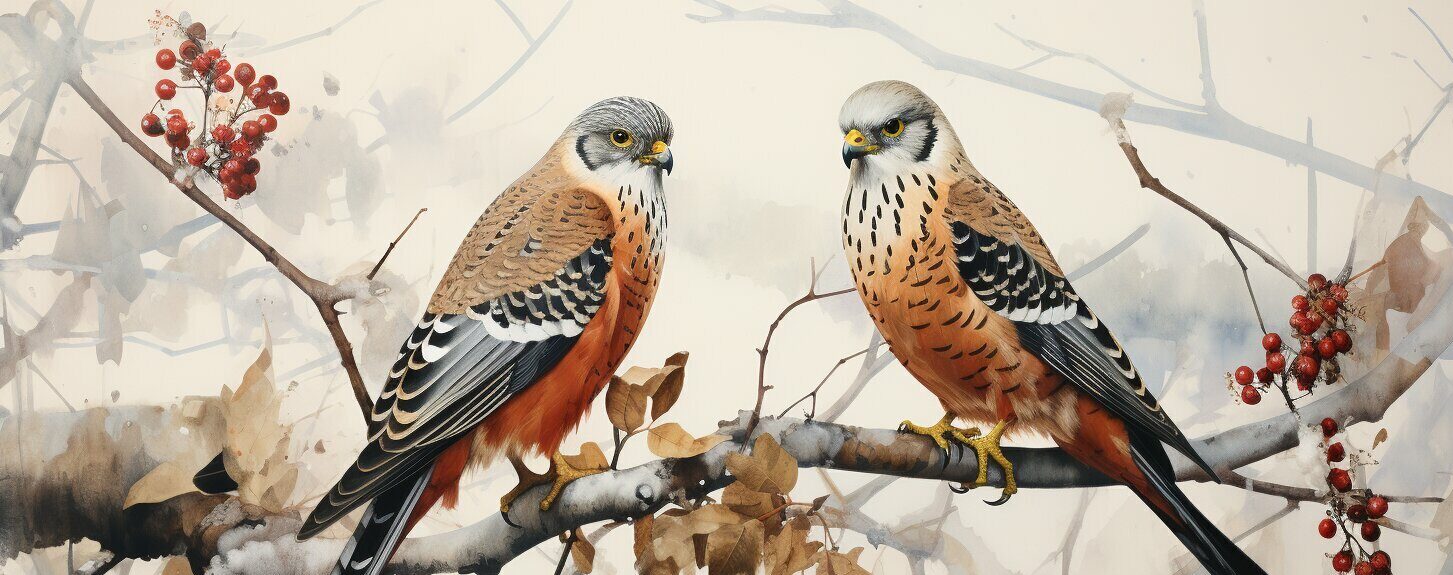When it comes to different species of owls, the Great Horned and Barn Owls are two of the most popular. While they share some similarities, there are also significant differences between the two. Let’s take a closer look at the key characteristics that distinguish Great Horned Owls from Barn Owls.
Key Takeaways
- The Great Horned Owl and Barn Owl may share some similarities, but there are also significant differences between the two species.
- Great Horned Owls are larger and more stocky, with distinctive “horns” on their heads, while Barn Owls have heart-shaped faces and lighter, more delicate bodies.
- These owls have unique physical adaptations and exceptional sensory abilities that make them successful nocturnal hunters in different habitats.
- By understanding the differences between these two species, we can better appreciate their adaptability and individual qualities.
Characteristics of Great Horned and Barn Owls
Great Horned and Barn Owls are two fascinating creatures with distinctive characteristics that set them apart from each other. Here are some of the most notable physical and behavioral traits that differentiate these birds of prey.
Physical Characteristics
The Great Horned Owl is a large bird, measuring 18-25 inches in length with a wingspan of up to six feet. They are recognized by their tufts of feathers on their heads that resemble horns, which are actually for display and not for hearing. They have piercing yellow eyes, and their mottled brown and white feathers provide great camouflage in wooded areas.
In contrast, the Barn Owl is smaller than the Great Horned Owl, measuring 12-16 inches in length with a wingspan of up to 44 inches. They have a heart-shaped face, pale feathers with black spots, and dark eyes. Their feathers are soft and fine, allowing them to fly silently through the air while hunting.
Sensory Abilities
The Great Horned Owl has exceptional sensory abilities with keen eyesight and hearing that enable them to hunt in low light or complete darkness. They have asymmetric ear openings, allowing them to triangulate sound and pinpoint prey. They can hear sounds up to ten times better than humans.
The Barn Owl’s hearing is even more impressive. They have a facial disc that funnels sound to their ears, allowing them to hear prey moving in complete darkness. They can detect sounds as low as 0.5 kHz, which is four times lower than humans can hear.
Adaptations for Nocturnal Hunting
Both Great Horned and Barn Owls have adaptations that enable them to hunt effectively at night. They have large eyes that gather more light, allowing them to see in low light. They also have a light-reflecting layer behind their retinas that increases their night vision. Additionally, their feathers have soft edges that muffle the sound of their flight, allowing them to swoop down on prey undetected.
Overall, Great Horned and Barn Owls are magnificent birds with their own unique characteristics that make them exceptional hunters and fascinating creatures to observe and learn about.
Habitats and Behaviors of Great Horned and Barn Owls
Great Horned and Barn Owls have distinct habitats and behaviors that make each species unique. These differences illustrate how each bird has adapted to its environment and hunting style.
Great Horned Owls
Great Horned Owls are known to inhabit a wide range of habitats, from forests and deserts to urban areas. They are often found in tall trees, where they build nests using sticks and other materials. These nests are frequently located near open areas, such as fields or meadows, where the owls hunt for prey. Great Horned Owls are also known for their distinctive “horns,” which are not actually horns but rather tufts of feathers on their heads that serve as camouflage.
When hunting, Great Horned Owls use their sharp talons and excellent vision and hearing to capture a variety of prey. They are able to fly silently through the air, which allows them to sneak up on their victims undetected. Great Horned Owls are also territorial birds and will aggressively defend their nests and territory from other birds, including other Great Horned Owls.
Barn Owls
Barn Owls, on the other hand, are typically found in open habitats such as grasslands, marshes, and agricultural areas. They prefer to roost and nest in cavities, such as hollow trees or abandoned buildings, though they will also make use of specially designed nest boxes. Barn Owls have evolved to have incredibly efficient hearing, allowing them to locate and capture prey even in complete darkness.
Unlike Great Horned Owls, Barn Owls are not territorial birds and will often nest in groups. They may also breed year-round if conditions are favorable. When hunting, Barn Owls use a combination of their excellent hearing and silent flight to capture small mammals such as mice and voles. Barn Owls are also able to fly low over crops, which helps them locate prey more easily.
In conclusion, while Great Horned and Barn Owls may look similar at first glance, they have distinct differences in terms of their habitats and behaviors. These differences demonstrate how each species has evolved to meet the demands of their environment and become successful nocturnal hunters.
Identification of Great Horned and Barn Owls
If you’re looking to identify a Great Horned Owl or Barn Owl, there are several key factors to consider.
Firstly, take a look at their physical appearance. Great Horned Owls are larger than Barn Owls, with distinctive plumage featuring the eponymous “horns” on their heads. Barn Owls, on the other hand, have heart-shaped faces and lighter, more delicate feathers.
Another crucial element to consider is their calls. Great Horned Owls have a deep, resonant hoot, while Barn Owls emit a high-pitched shriek or hiss. Observing their flight patterns can also help with identification – Great Horned Owls tend to fly in a straight line, while Barn Owls fly with a distinctive buoyant motion.
Of course, these are just general guidelines – the exact appearance and behavior of each individual owl can vary widely. For more in-depth guidance on owl identification, consult a reputable field guide or visit an expert in your area.
Fun fact: Did you know that Great Horned Owls are sometimes called the “tiger owl” due to their striking striped plumage?
Comparison of Great Horned and Barn Owls
While Great Horned and Barn Owls share some similarities, such as their nocturnal hunting habits and exceptional sensory adaptations, there are several distinct differences between the two species.
| Great Horned Owls | Barn Owls |
|---|---|
| Large, stocky build with distinctive “horns” | Slender build with heart-shaped face |
| Deep hooting call | High-pitched shriek or hiss |
| Prefer woodland and forested areas | Prefer open fields and grasslands |
By understanding these differences, you can more easily tell these two magnificent species apart. Whether you catch a glimpse of a Great Horned Owl in flight or spot a Barn Owl hunting prey at night, you’ll be able to appreciate the unique beauty and skill of each owl species.
Similarities and Distinctions Between Great Horned and Barn Owls
Although Great Horned and Barn Owls exhibit distinct differences, they also share many similarities. By comparing and contrasting these owl species, readers will gain a deeper appreciation of their unique characteristics.
Similarities:
Great Horned and Barn Owls share several similarities that make them the perfect nocturnal predators. Here are some common traits of these two owl species:
| Similarities |
|---|
| Both Great Horned and Barn Owls are primarily nocturnal hunters, with keen night vision and hearing abilities that enable them to locate prey in complete darkness. |
| They both have silent flight, which helps them to ambush unsuspecting prey without alerting them. |
| Great Horned and Barn Owls both have sharp talons and beaks, which they use to capture and kill their prey quickly. |
| They both play essential roles in the ecosystem. Barn Owls are known to prevent rodent populations from exploding, while Great Horned Owls keep other owl species at bay. |
Distinctions:
Although Great Horned and Barn Owls share many similarities, there are also plenty of differences that set them apart. Some notable distinctions include:
| Distinctions | Great Horned Owls | Barn Owls |
|---|---|---|
| Physical Appearance | Great Horned Owls have distinctive “horns” or tufted feathers on their head and feather-covered feet. | Barn Owls have a heart-shaped face with no ear tufts and long, fluffy feathers on their legs. |
| Habitat | Great Horned Owls can be found in a wide range of environments, from forests to suburban areas. | Barn Owls prefer open fields and grasslands where they can easily hunt their prey. |
| Nesting Habits | Great Horned Owls are known to nest in a variety of locations, including tree hollows, cliffs, and abandoned buildings. | Barn Owls prefer to nest in cavities such as hollow trees or barns. |
| Call | The Great Horned Owl has a distinctive hoot that sounds like “Hoo-hoo-hoo-hoo” with a deep tone. | The Barn Owl has a screeching scream-like call that sounds like “shreeee” or “skee-ik”. |
While Great Horned and Barn Owls share many similarities, it’s the differences that make them unique. Understanding these differences is essential to appreciate and protect each species for generations to come.
Conclusion
Great Horned and Barn Owls are two distinct species of owls that share some similarities but differ in several ways. From their physical characteristics and hunting techniques to their preferred habitats and behaviors, these owls have unique features that make them fascinating creatures to observe.
Great Horned Owls, for instance, are larger and bulkier than Barn Owls and have distinctive ear tufts that resemble horns. They are also formidable hunters capable of taking down prey as large as skunks and rabbits. Barn Owls, on the other hand, have a heart-shaped facial disc and are known for their silent flight. They prefer to hunt small mammals like rodents and have adapted to living in diverse habitats such as farmlands and forests.
While both Great Horned and Barn Owls are exceptional nocturnal hunters, they differ in their nest-building habits and territorial behaviors. Great Horned Owls are known to take over the nests of other birds, while Barn Owls create their own nests in tree cavities or man-made structures. Great Horned Owls are also fiercely territorial and can drive away other predators, including fellow Great Horned Owls, while Barn Owls are non-territorial and can coexist peacefully in close proximity to one another.
In conclusion, understanding the features, behaviors, and habitats of Great Horned and Barn Owls can help us appreciate the unique qualities of these fascinating creatures. By comparing and contrasting these two species, we gain a deeper understanding of their individual attributes and how they have adapted to their respective environments.
 Skip to main content
Skip to main content


